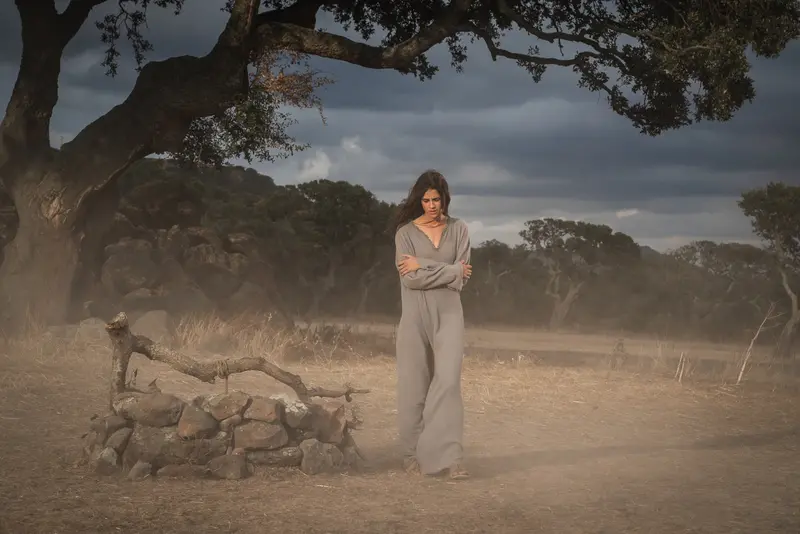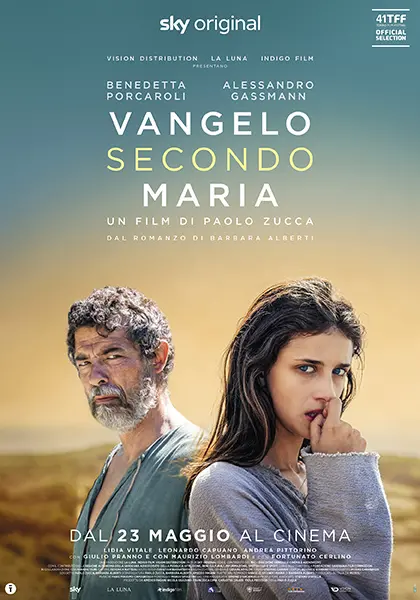

Vangelo secondo Maria is a love story – that between Mary, a girl from Nazareth, and Joseph, her teacher and accomplice. Although, as a woman, everything is forbidden to her, even learning to read and write, she dreams of freedom and wisdom. She is enthusiastic about the stories of the Bible. She wants to escape on a donkey and discover the world, so decides to disobey the rules of society. Her husband, Joseph, is secretly instructing her and preparing her for her getaway, when the pair unexpectedly falls in love.
Director Paolo Zucca wanted to give Vangelo secondo Maria the recognisable narrative context of the Bible, although one of its distinctive elements is its setting in a clearly local geographical location, Sardinia. There was never any thought of faithfully reconstructing the presumed historical reality of Galilee two thousand years ago, and even less of evoking the stereotyped imagery of an exotic nativity scene with turbans and palm trees. Rather, the aim was to evoke the shared Mediterranean heritage of ancient agricultural-pastoral civilisations, using the extraordinary archaeological and anthropological patrimony of Sardinia. This approach arose from the desire to create an original poetic universe, as sober in its staging of the archaic world as it is imaginative in its reworking of the Biblical story.
Locations included the interior of the Early Christian Basilica of San Giovanni di Sinis, in Cabras (province of Oristano), which was used for the synagogue of Nazareth, where the priest reads passages from the Old Testament during a religious ceremony while a prophet recites verses from Isaiah outside.
The Colle di San Michele Park, a green area on the outskirts of Cagliari, served as a location with the production shooting for three days in a cavity in the rock beneath the medieval castle. The cave provided the interiors corresponding to the exteriors of a domus de janas in Villa Sant' Antonio in Marmilla (Oristano). Also in Marmilla, scenes with temple merchants were filmed in Siddi. Another location was Montiferru, Sardinia’s largest complex of volcanic origin which overlooks the gulf of Oristano and the wooded plateau of Abbasanta.
Locations also included the province of Nuoro: in particular, an area of the Flumendosa river in the Gadoni area for the river scenes; and the nuragic complex of Tamùli, an important archaeological area dating to the Mid Bronze Age in Macomer.
Vangelo secondo Maria is a love story – that between Mary, a girl from Nazareth, and Joseph, her teacher and accomplice. Although, as a woman, everything is forbidden to her, even learning to read and write, she dreams of freedom and wisdom. She is enthusiastic about the stories of the Bible. She wants to escape on a donkey and discover the world, so decides to disobey the rules of society. Her husband, Joseph, is secretly instructing her and preparing her for her getaway, when the pair unexpectedly falls in love.
Director Paolo Zucca wanted to give Vangelo secondo Maria the recognisable narrative context of the Bible, although one of its distinctive elements is its setting in a clearly local geographical location, Sardinia. There was never any thought of faithfully reconstructing the presumed historical reality of Galilee two thousand years ago, and even less of evoking the stereotyped imagery of an exotic nativity scene with turbans and palm trees. Rather, the aim was to evoke the shared Mediterranean heritage of ancient agricultural-pastoral civilisations, using the extraordinary archaeological and anthropological patrimony of Sardinia. This approach arose from the desire to create an original poetic universe, as sober in its staging of the archaic world as it is imaginative in its reworking of the Biblical story.
Locations included the interior of the Early Christian Basilica of San Giovanni di Sinis, in Cabras (province of Oristano), which was used for the synagogue of Nazareth, where the priest reads passages from the Old Testament during a religious ceremony while a prophet recites verses from Isaiah outside.
The Colle di San Michele Park, a green area on the outskirts of Cagliari, served as a location with the production shooting for three days in a cavity in the rock beneath the medieval castle. The cave provided the interiors corresponding to the exteriors of a domus de janas in Villa Sant' Antonio in Marmilla (Oristano). Also in Marmilla, scenes with temple merchants were filmed in Siddi. Another location was Montiferru, Sardinia’s largest complex of volcanic origin which overlooks the gulf of Oristano and the wooded plateau of Abbasanta.
Locations also included the province of Nuoro: in particular, an area of the Flumendosa river in the Gadoni area for the river scenes; and the nuragic complex of Tamùli, an important archaeological area dating to the Mid Bronze Age in Macomer.

La Luna, Indigo Film, Vision Distribution, Sky